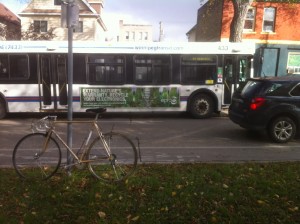By Zanna Joyce.
About two and a half years ago, I was spending a Saturday getting ready to head off on a trip to Montreal the next day. I had a whole list of things to do so I jumped in the car, and fired it up.
Nothing.
I asked my neighbour to boost it.
Nothing.
I pulled out my list and started to review it, and realized with some degree of amazement that there was only one thing on the entire list that I had to do before I left.
The one thing I needed to do was to go to the bank. There was a branch on the way to the airport.
We made our flight and spent an entire week enjoying Montreal using the subway and bus system, and getting lots of exercise walking here and there. We enjoyed the excellent intra-city bus service, taking several side trips. I returned to Winnipeg fully immersed in an urban vibe.
I knew that if I got the car fixed when we got back I’d lose that vibe. I love driving. I love being able to run around, I love having the windows open and the stereo playing great music. But I had been wanting to start using transit. I am 20 minutes from nearly everywhere I need to get to. So I made the decision to leave the car where it was—for the long term.
It took a while to get used to the system. I thought I would have to walk a lot. I told myself that was great, I would get exercise. But over time, I realized that at least in the more central areas of the city, and for major routes, walking was often unnecessary. Run around the corner and you’ll find a bus that will take you right to the door of your destination.
I thought that it would be expensive, that I’d have to take taxis all the time. After all, when I had had an injury some years back that made driving impossible, I had to take taxis.
Well, without the running costs of the car, paying for the monthly pass instead, I was already saving quite a bit, and of course, there were no surprise bills. I saved enough to pay for the odd taxi if I needed it. But as I became better at rationalizing my trips and eliminating the short trips, I found this was rarely necessary. After 2.5 years, I haven’t even spent one month worth of operating expenses on taxis.
I’ve also gotten to meet more of my neighbours, and see old friends from the community centre. I’m nice to the drivers, saying good morning and thank you, and they are good to me, waiting a couple of seconds for me if they see me running.
I feel way better not dragging 2 tonnes of metal around with me everywhere I go. I have downloaded a schedule program for my phone so that I always know when buses are coming and I carry a messenger bag with things I might need in a day, same as I did in the car.
Overall, it has been an excellent transition. I still have the car, and it is still not functioning. I think about taking it in, hoping that using transit is entrenched enough in my schedule that I won’t go back to daily use, but really, the more appropriate plan would be to join the car co-op or to rent a car once a month, if I really needed it.
It would be more difficult if I had small children to get to school, daycare and activities, or a job that was in an area with poor transit access. But this is what needs to be addressed. Ensuring very high frequency on as many routes as possible, and ensuring that routes connect well and travel through neighbourhoods so that people can get to the places they need to go would make it much easier for everyone who has to use, or chooses to use transit.
It’s great to feel that I am not contributing as much to congestion. When buses are full I am contributing less to pollution. And I appreciate the time I have on the bus to read, or daydream, or to chat with neighbours. My bus conversion is complete.
Zanna Joyce is a former president of two downtown residents associations and a member of the Functional Transit Winnipeg Steering Committee..

